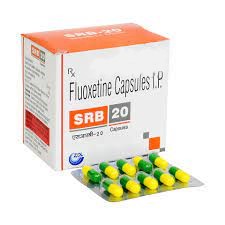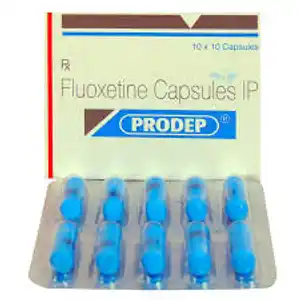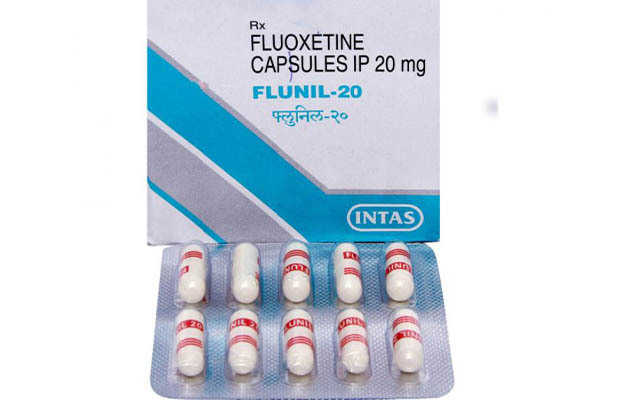Fluoxetine
Major Depressive Disorder, Bulimia ... show more
DRUG STATUS

Approvals
US(FDA), UK(BNF)

Essential Medicine
YES

Teratogenicity
N/A

Pharmaceutical Class
Serotonin Reuptake Inhibitor

Fluoxetine
Know More About This Medicine -
Click HereSummary
Fluoxetine is primarily used to treat conditions such as major depressive disorder, generalized anxiety disorder, obsessive-compulsive disorder, panic disorder, bulimia nervosa, and premenstrual dysphoric disorder.
Fluoxetine works by increasing the levels of serotonin, a neurotransmitter in the brain. This helps improve mood, anxiety, and overall emotional wellbeing.
The usual daily dosage for adults is 20 mg, typically taken once in the morning. Depending on the condition being treated, the dosage may be increased gradually up to a maximum of 80 mg per day. It can be taken with or without food.
Common side effects include nausea, headache, insomnia, dizziness, dry mouth, fatigue, and potential sexual dysfunction. More severe effects can include serotonin syndrome symptoms, suicidal thoughts, and severe allergic reactions.
Fluoxetine carries warnings for people with a history of suicidal thoughts, particularly in young adults. It should not be used with MAO inhibitors or within 14 days of stopping them. Individuals with liver disease, seizure disorders, or bipolar disorder should use caution. It is also contraindicated in people who are allergic to Fluoxetine.
Indications and Purpose
What is Fluoxetine used for?
Fluoxetine is primarily indicated for the treatment of:
- Major depressive disorder (depression)
- Generalized anxiety disorder
- Obsessive-compulsive disorder (OCD)
- Panic disorder
- Bulimia nervosa
- Premenstrual dysphoric disorder (PMDD)
How does Fluoxetine work?
Fluoxetine works by inhibiting the reuptake of serotonin, a neurotransmitter, in the brain. By blocking the reabsorption of serotonin, it increases the levels of serotonin available in the brain, which helps regulate mood, emotions, and behavior. This mechanism is thought to improve symptoms of depression, anxiety, and other mood-related disorders by enhancing serotonin signaling in areas of the brain involved in mood regulation.
Is Fluoxetine effective?
Numerous clinical studies and trials have demonstrated that Fluoxetine is effective in treating depression, anxiety, OCD, and other mood disorders. Research shows that Fluoxetine helps to improve mood, reduce anxiety, and decrease obsessive thoughts by increasing serotonin levels in the brain. Studies have consistently found that Fluoxetine is more effective than a placebo in treating major depressive disorder, and its benefits are sustained with long-term use, making it a widely recommended and prescribed SSRI.
How does one know if Fluoxetine is working?
The benefit of Fluoxetine is evaluated through regular monitoring of symptom improvement, typically by assessing mood, anxiety levels, and other related symptoms. Healthcare providers may use rating scales, such as the Hamilton Depression Rating Scale or the Beck Depression Inventory, to track progress. Additionally, the patient’s response to treatment, including any side effects or changes in behavior, is reviewed during follow-up appointments to ensure the medication is effective and well-tolerated.
Directions for Use
How do I take Fluoxetine?
Fluoxetine can be taken with or without food, as food does not significantly affect its absorption. There are no specific food restrictions while taking Fluoxetine. However, it's advisable to avoid alcohol, as it may increase the risk of side effects like dizziness, drowsiness, and impaired judgment. Consistency in taking Fluoxetine at the same time each day is important for optimal results. Always follow your healthcare provider’s instructions for proper use.
For how long do I take Fluoxetine?
It takes about a month for the medicine to build up to its full effect in your body. Even after you stop taking it, some of the medicine stays in your system for several more weeks. How long it stays depends on you, how much you took, and how long you took it.
How long does it take for Fluoxetine to start working?
Fluoxetine typically starts showing effects within 1 to 2 weeks, but it may take 4 to 6 weeks to feel the full benefits, especially for mood improvement in depression or anxiety. For some people, it may take longer to notice significant changes. It’s important to continue taking the medication as prescribed, even if immediate improvements aren’t apparent.
How should I store Fluoxetine?
Fluoxetine should be stored at room temperature, between 68°F and 77°F (20°C to 25°C), away from light and moisture. Keep the medication in its original container with the lid tightly closed to protect it from air and humidity. Ensure it is kept out of reach of children, and never store it in a bathroom or kitchen where humidity levels may be high.
Warnings and Precautions
Who should avoid taking Fluoxetine?
Fluoxetine carries important warnings for people with a history of suicidal thoughts or behaviors, particularly in young adults, as it may increase the risk of suicide. It should not be used with MAO inhibitors or within 14 days of stopping them, as this can lead to dangerous interactions. Individuals with liver disease, seizure disorders, or bipolar disorder should use Fluoxetine with caution. It is also contraindicated in people who are allergic to Fluoxetine or any of its ingredients. Always consult a healthcare provider before starting the medication.
Can I take Fluoxetine with other prescription drugs?
Fluoxetine has significant interactions with several prescription drugs. It should not be taken with MAO inhibitors (e.g., phenelzine, tranylcypromine) due to the risk of serotonin syndrome, a potentially life-threatening condition. Combining Fluoxetine with other SSRIs, SNRIs, or tricyclic antidepressants can increase the risk of serotonin syndrome and other side effects. It may also interact with anticoagulants (e.g., warfarin) and nonsteroidal anti-inflammatory drugs (NSAIDs), increasing the risk of bleeding. Caution is also needed when combining Fluoxetine with lithium or antipsychotic medications. Always inform your doctor about all medications you are taking.
Can I take Fluoxetine with vitamins or supplements?
Fluoxetine can interact with certain vitamins and supplements. The most significant interactions are with St. John's Wort, which may increase the risk of serotonin syndrome when combined with Fluoxetine. Vitamin E and vitamin C may increase the risk of bleeding when taken with Fluoxetine, particularly in people with pre-existing bleeding disorders. Always consult a healthcare provider before taking supplements along with Fluoxetine to avoid potential interactions.
Can Fluoxetine be taken safely while pregnant?
Fluoxetine is classified as a Category C medication for pregnancy, meaning that its safety during pregnancy has not been fully established. Animal studies have shown potential risks, but there are no well-controlled human studies. While it may be prescribed during pregnancy if the benefits outweigh the risks, Fluoxetine can be associated with withdrawal symptoms in newborns if taken late in pregnancy. Some studies also suggest a slightly increased risk of premature birth or low birth weight. It's important for pregnant women to discuss the potential risks with their healthcare provider.
Can Fluoxetine be taken safely while breastfeeding?
Fluoxetine is excreted in breast milk, and while it is generally considered safe for short-term use during breastfeeding, there is a potential risk of side effects in the infant, such as irritability, poor feeding, or drowsiness. The American Academy of Pediatrics classifies Fluoxetine as compatible with breastfeeding, but it is advised to monitor the infant for any adverse effects. A healthcare provider should be consulted to weigh the risks and benefits, especially for long-term use.
Is Fluoxetine safe for the elderly?
Fluoxetine works about the same for older people as it does for younger people, but some seniors might be more sensitive to it. Low sodium levels in the blood are a possible side effect. Because older folks often have other health problems and take other medicines, a doctor may start them on a lower dose or give it less often.
Is it safe to exercise while taking Fluoxetine?
Fluoxetine generally does not hinder your ability to exercise, whether moderately or strenuously. Most people can engage in physical activities without significant issues. However, some individuals may experience side effects like fatigue or dizziness, especially when starting the medication or adjusting doses. These effects could make exercising more challenging. If you notice increased tiredness or any other symptoms that affect your workout routine, it’s a good idea to talk to your doctor. They can help determine if adjustments are needed or if another treatment might be better suited for you.
Is it safe to drink alcohol while taking Fluoxetine?
Drinking alcohol while taking fluoxetine is not recommended as it may increase side effects like drowsiness and impair judgment. Moderate consumption could affect the medication's effectiveness and safety, so it's best to discuss alcohol use with a healthcare provider.






.svg)






